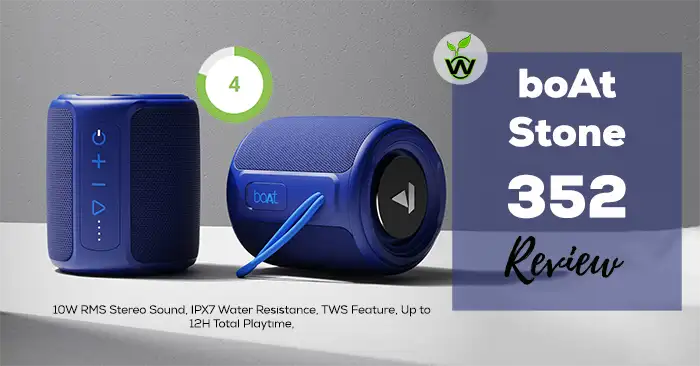Choose the Best PCIe WiFi Card for Your PC: A PCIe Wi-Fi card is required to add a wireless connection to computers and laptops by plugging it directly into an empty slot on the motherboard. Wi-Fi cards are updated yearly to meet new speed standards and provide users with more stability on smart devices.
802.11b first became popular in the Internet community, but the original 801.11a was the base for that card. There have been some significant improvements in Wi-Fi cards since then, and we now have more stable, low-latency, faster cards out there that customers can buy.
Immediately after the introduction of Wi-Fi 6 (also known as 802.11ax) last year, a new standard was introduced. Now, more people using this technology have managed to break the 3000Mbps limit while remaining connected to multiple devices at the same time.
Wi-Fi 6 kicked off well, but after a few months sales started to slow down. However, we are seeing new devices coming out that support Wi-Fi 6 connection to give you a fast and stable internet connection. This is great news for someone who has a new computer in 2022 because they will have better internet access than anyone before.
Also Check:Best Floor Lamps for Reading : Highly Rated Lamps
Users with older devices are not as lucky as the new Wi-Fi 6 routers can complicate the whole situation and limit your bandwidth due to lack of processing power. So upgrading your computer to the latest standard is the only option left for people who need to use the Wi-Fi 6 route for their daily internet activities.
Buying the best PCIe WiFi card on the market is the ideal choice to ensure that your computer does not experience any network issues. However, it is a bit difficult to choose the right Wi-Fi card for your device as it comes in various shapes and sizes, which makes the job unpleasant for most people.
Here we listed some of the best PCIe WiFi cards that can maximize your Internet speed with stability. We started our test with the Asus AX3000 (Pce-AX58BT), a popular card best known for its smart dual-band adapter, which also works with next-gen Wi-Fi 6 and Bluetooth 5.0. Plus, we also took a look at some other companies’ Wi-Fi cards like MSI, WAVELINK, and EDUP to pick the winners. So here’s everything you need to know:
How to choose the Best PCIE WiFi Card?
You need to know basic things before talking about individual Wi-Fi cards on the market. That way, you’ll know the basics of comparison to make a better choice when choosing a device on your own. Here are the most important things to consider before choosing the next WiFi card for your computer:
Bandwidth
Bandwidth is the most important thing on a wireless card. Bandwidth is basically the data transfer rate of a wireless card from one connection to another. The higher the bandwidth, the better speed you get with the connection. One Gigabyte was the standard for older cards used before Wi-Fi 6 was introduced, but things have changed dramatically. Wi-Fi 6 now offers user speeds of up to 3000 Mbps on paper for a total bandwidth of 3 gigabytes.
Speaking of gigabytes, Ethernet is still one of the fastest, most reliable, and least latent connections out there, but it’s impossible to stay grounded all the time. As a result, WiFi cards have become a great alternative with little compromise in speed and latency. However, note that most tests are run on perfect settings when the speed is measured with a perfect environment that you can’t match at home. Another reason for bandwidth loss is that users connect to multiple devices on home internet service at the same time, decreasing the overall bandwidth every second. So don’t judge a wireless router based solely on the highest possible speed, as there are many features to look out for.
Must Read:Best Inventions of 2021 : Hope for a Better Future
Number/Types of Antennas
The trap set by many WiFi brands is to show multiple antennas on the Wi-Fi card, but more antennas don’t make more sense every time. So don’t get distracted by a bunch of antennas and see how much power they put out for the whole setup. The router may need more antennas to carry the Wi-Fi signal in all possible directions, but this is not the case with the Wi-Fi card, which receives the signal from a single direction. Antennas on your computer pointing in the right direction can easily be connected to your router. Therefore, for most of us, there is no need to have more than one antenna.
You can choose a Wi-Fi card that has two antennas pointing towards your router, as they will provide long distances while boosting the overall signal at the same time. What you should check is the antenna size. Longer antennas have better signal strength, range, and performance to overcome interference in the area. Depending on the range, try selecting the antenna size. For example, if your router is 30 meters apart from your computer, try using a long antenna to support the signal. However, when the distance is closer, any antenna will work. If the antenna range is short, you also have the option of purchasing a separate longer range antenna at a later date to amplify the signal without having to pay a lot online.
Card Size
Many people forget to check the physical size of the Wi-Fi card and then regret it later on because the card won’t fit on the computer. All PCIe wireless cards only fit into one slot on your computer/laptop, but they come in different sizes and shapes for different devices, which makes things complicated. Anyone who has a full-size tower case suitable for a large graphics card need not worry because you can simply plug in any Wi-Fi card. Now, if you have a mini or micro case type, before making a decision, check the size of the WiFi card and see if it fits your device. Also, check the PCIe port size and if the size doesn’t match, you will have to choose another card.
Cooling Problems
Depending on your computer, cooling may or may not be a major issue for most Wi-Fi adapters. A computer case with good ventilation and precise heat sink control does not require an additional PCIe wireless card fan. However, there are plenty of wireless card coolers online that will help anyone involved with a heating system. This will keep the entire card cool and will help you get the best performance while your computer is running.
Make sure there is adequate airflow in your cabinets as coolers for wireless cards will absorb heat and return heat to the cabinets when fully closed. After all, a WiFi card is made up of circuits that, over time, get hot and can even fail if you don’t take proper action. Another mistake that users usually make is placing the Wi-Fi card right in front of the graphics card exhaust fan, which over time will degrade the performance of your card. Try to keep the two cards separate so you never run into problems with overheating components on the PC.
Also Read:JBL Vibe 100 TWS Review : What about Open Case Design?
Driver Support
Most wireless cards are plug-and-play, so you don’t need to install drivers, which makes the process a lot easier for the average user. For other cards, you need to consider if the driver supports your system. Downloading a driver is a simple task, but you will need them to work properly with your personal PC. One surefire way to check support drivers is to visit the manufacturer’s website and manually check the specifications one by one. Also, don’t opt for a Wi-Fi card that came out two years ago or so to keep getting the latest hardware compatible with the latest computers.
Top 4 Best PCIe WiFi Cards
1. Asus AX3000 (Pce-AX58BT)
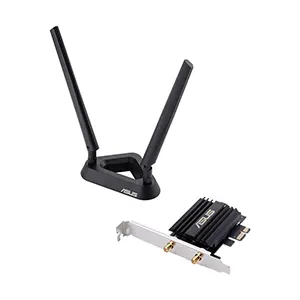
Asus has made a name for itself in the computer space with some of the best products, including great network devices like WiFi cards. The Asus AX3000 (Pce-AX58BT) is an excellent wi-fi card, which is made of an aluminum plate and a flat design, covered in black for basic use. Thanks to the open frame, there are little to no heating problems and you can easily mount the antenna anywhere, as they are detachable. The dual antenna setup also connects to other third-party devices, so people who need more coverage don’t get stuck with this WiFi card built-in hardware.
The Asus AX3000 antenna base is magnetic, which can be easily attached to any metal surface such as your computer case, and you get an extension cable to make your Wi-Fi card mobile. The 5 GHz channel can provide data transfer rates of up to 2400Mbps and the 2.5GHz channel offers 600Mbps speed. Plus, with the latest WPA3 security, you can surf the web for free without needing a VPN to protect your identity online.
Also Check:diib Review : Is it Worth for your Website and business?
OFDMA and MU-MIMO are included in the wireless card to manage multiple connections over the network without causing long delays in a system. The Asus 9-pin USB header lets you connect the Wi-Fi card to your computer and use the latest Bluetooth 5.0 for smooth data transfers over the air. Besides being compatible with Windows 10, the WiFi card supports both 32-bit and 64-bit Linux systems, so users don’t have to switch operating systems just to use Wi-Fi 6 on their computers.
2. MSI AX916C AX200
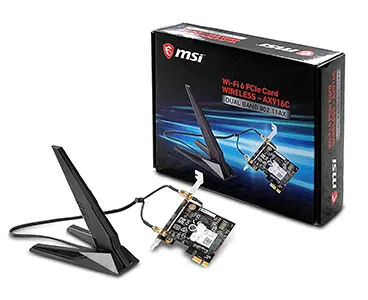
Like Asus, MSI is a well-known brand in the industry but focuses more on cards and computer peripherals. After looking at the MSI AX916C AX200, we found that the WiFi card is much narrower but still has enough power for your internet speed. The antenna is large and heavy, but you can easily attach it anywhere around your computer. Unfortunately, it is not possible to adjust the angle of the antenna and you are limited to a one-directional signal or stuck readjusting the entire setup.
The Wi-Fi card can provide up to 3,000Mbps of bandwidth with the antenna while staying connected to Bluetooth 5.0 at the same time. So why isn’t this card in the first place you may ask? There is one serious drawback to the MSI WiFi card which allows you to connect Bluetooth only to Intel chips and not to AMD motherboards. People who have AMD builds can only use this card to a limited extent. In general, you can connect to Windows 7, 8.1, and 10 without any information about other operating systems on the market.
3. WAVLINK AX3000
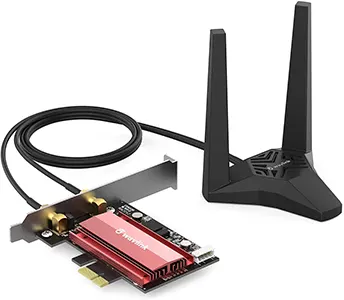
WAVELINK has been producing efficient and productive cards for users trying to get the latest Wi-Fi 6 in their systems for more than three years. The WAVLINK AX3000 has a dual antenna setup that attaches magnetically to your desk for a more convenient installation. The card is highly portable, with an aluminum structure that quickly attaches to a PCIe port on a computer for a secure WPA3 connection.
WAVLINK antennas cannot fit into large cases because they use more space and provide better speeds to any wireless device connected to your network. Like the Wi-Fi card above, it supports 3,000 Mbps bandwidth and a multi-device protocol for sharing the network with other devices in your home. You get the Bluetooth 5.1 version, which connects to the motherboard using the 4-pin cable to offer incredible speed to consumers.
Also Check:WazirX Review : Review of India’s Leading Crypto Exchange
Unlike other wireless cards mentioned above, you need to download the drivers from the official WAVLINK website before making any connection. In addition, people using Windows 10 64-bit operating system as the base software can only use this card, which is very restrictive for other types of programs.
4. EDUP PCIe WiFi 6 Card
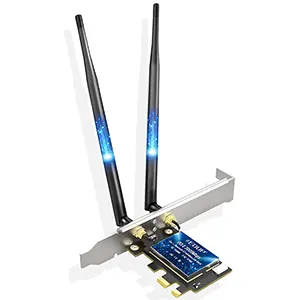
The EDUP wireless card also comes with two channels that you can connect to get stable speed on demand. The 5 GHz channel offers a data transfer rate of 2400 Mbit/s, while the 2.5 GHz channel only stays around 600 Mbit/s. The card has two antennas mounted on the back, which reduces the overall mobility of the device.
The built-in Bluetooth 5.1 module is a big benefit when buying this EDUP WiFi card as it helps you achieve a stable connection at higher speeds. Plus, you don’t need any downloaded drivers to boot the device, which was a must with WAVLINK. So people can plug and play the card wirelessly to use a fast internet connection from anywhere in the house.
On the other hand, EDUP WiFi cards are only compatible with Windows 10, so users who need this speed and stability will have to upgrade from old Windows to newer ones or change the computer’s operating system completely. What sets this card apart from other WiFi cards is the use of the built-in antenna and the mother’s 9-pin interface instead of 4-pin, which is mandatory for Bluetooth.
Verdict: Best PCIe WiFi Cards
People who need a strong WiFi connection at home can use a WiFi card connected to their desktop computer for WiFi 6 coverage. This largely ensures that you don’t have to experience network failures in your home to always stay connected to the Internet. Of course, the Asus AX3000 (Pce-AX58BT) is the right choice for most people who need good connectivity. This device not only supports Bluetooth 5.0 but also offers stable 2.5 and 5GHz channels.
Other devices like MSI, WAVELINK also cover the bandwidth of WiFi 6, but you have to download separate drivers and it is limited to Windows users which is not so ideal. Lastly, the EDUP PCIe WiFi 6 card comes with an open design, which is perfect for small computers but has the disadvantage of a non-removable antenna, which, depending on the location of your computer, can interfere with coverage.





